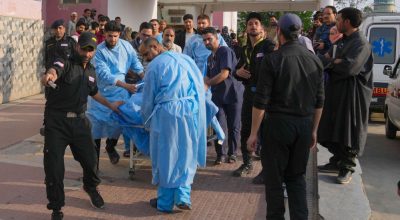
Parasi : Geo-physics survey has been carried out with the involvement of British geophysicists at Ramgram Stupa premises in Paschim Nawalparasi.
This is the fourth such survey carried out at the monument site which houses the relics of Gautam Buddha.
A team of experts from the Government of Nepal, Department of Archaeology, the Lumbini Development Trust and Durham University, UK conducted an extensive survey around the Ramgram Stupa area which is in the process of being included in the lost of world heritage sites. Survey study that started on November 7 concluded on November 13.
The survey is carried out with the financial assistance provided through UNESCO by the France-based Oriental Cultural Heritage Sites Protection Alliance.
Archaeologist at the Department Bishnu Pathak said the team has studied and observed the subterranean structures around the Stupa area. According to him, the detailed report of the survey will be released in January.
The experts’ team has now reached Tilaurakot for the same purpose after completing the archaeological survey here.
Pathak shared that a three-member team of experts including two foreigners carried out three types of survey within a 500 metres perimeter around the Stupa area.
The team is now integrating the geo-physics, field walking and the ‘agarkor’ technology study. Its detailed report will be available in January.
We have arrived in Tilaurakot on Wednesday after completing the works in Ramgram. We will submit the preliminary report within some days,” he said.
He informed that indications of important archaeological evidence have been seen at all places where the survey has been carried out.
The experts’ team had carried out the study through the geo-physics technology in open spaces and through the agarkor method at places with bushes.
The archeologists’ team has stated that the remnant of a wall have been found below the surface in the area covered with bush and open area towards the south of the Stupa.
Pathak added that the information on the structures seen in the rest of the areas would be known only after the detailed report is released.
The survey team is preparing to declare the spots where the findings have been detected as restricted area and keep signs to caution the locals from constructing any type of structures or digging the soil there.
In the geo-physics survey conducted in 2018, the ramparts of what looked like a monastery spread in large area and a pond were found towards the northern side of the Ramgram Stupa.
Vice-chairman of the Lumbini Development Trust, Bhikkhu Maiteya said the extensive survey has been carried out this time to collect adequate archaeological evidences to have the Ramgram included in the list of world heritage sites and also to give complete shape to the master plan prepared for the overall development of Ramgram.
Before this, geo-physics survey was conducted at Ramgram Stupa area in 1997, 1999 and 2018.
The Ramgram Stupa was discovered by archaeologist of Asiatic Society of Bengal, Dr. W. Hoey in 1899 as a huge round brick mound totally hidden by grass and bushes.
But it took another 65 years to confirm that the brick mound was a Stupa with Buddha’s relics.
Archaeological excavation was carried out in different phases from 1999 to 2004 under the leadership of archaeologist Shukra Sagar Shrestha after the remnants of a monastery were detected around the Stupa area from the geophysics survey conducted in 1997 and 1999.














